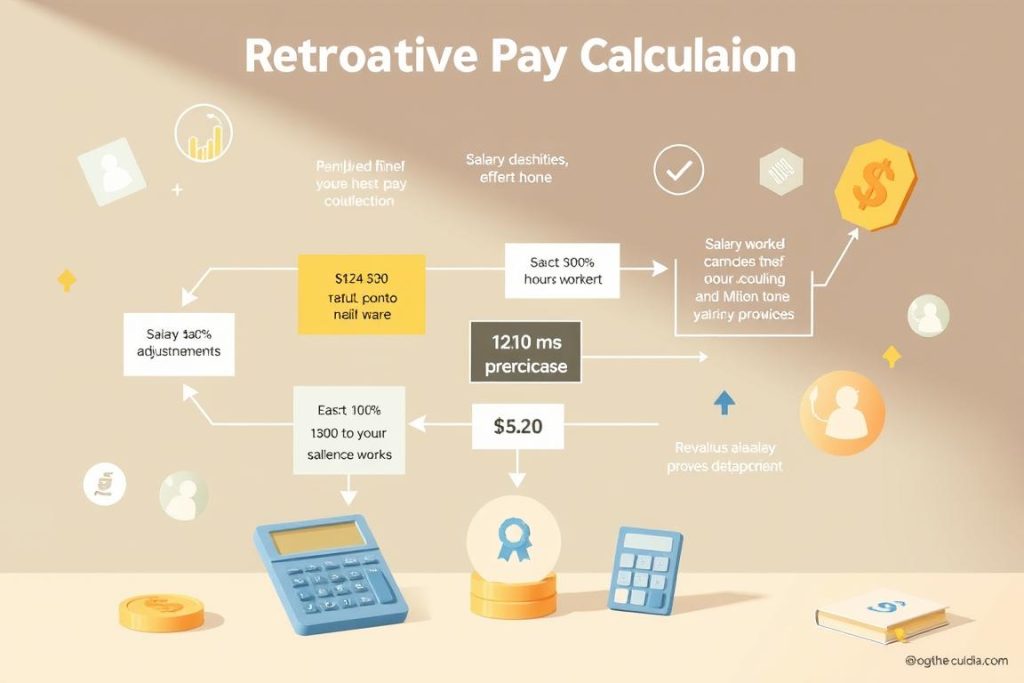Imagine working hard, only to find mistakes on your pay stub. John, a dedicated graphic designer, noticed his overtime wasn’t paid correctly. This wasn’t just a minor error; it greatly affected his life. Understanding employee remuneration, including back pay and retroactive pay, is crucial. Errors in payroll can harm the trust between employees and employers in the long run.
Payroll mistakes damage more than just numbers; they’re failures in meeting employer obligations. The Fair Labor Standards Act (FLSA) sets a deadline for fixing these wage discrepancies. This creates urgency for financial rectification and lost wages recovery1. Employers face hefty fines if they don’t keep their payroll accurate and fair.
Not paying employees like John for their hard work is against the law1. Understanding back pay and retroactive pay is essential. It shows the importance of fair labor practices for both employers and employees.
Key Takeaways
- Recognize the impact of payroll errors on trust between employers and employees.
- Understand employer obligations to correct wage discrepancies, including the significance of back and retroactive pay.
- Learn about the FLSA’s statute of limitations for recovering back pay and the legal considerations involved1.
- Distinguish between back pay for unpaid work and retroactive pay for underpayment.
- Comprehend the legal ramifications and financial responsibilities of employers in the event of payroll mistakes.
Difference Between Back Pay and Retroactive Pay
Understanding back pay and retroactive pay is key in the work world. Each has a unique role in ensuring correct pay.
Defining Back Pay and Its Use Cases
Back pay is money owed for past work not paid at the time. Errors or misclassified jobs often cause this.
It fills the gap from when you should have been paid to when the problem is fixed2.
Retroactive Pay – Correcting Underpayment Issues
Retroactive pay fixes when you were paid, but not the right amount. It corrects overdue pay, errors, or wrong overtime pay.
This helps stay in line with labor laws by paying what was shorted3.
Common Reasons for Underpayment Leading to Retro Pay
Retro pay is often needed for tax mistakes, wrong job classification, or incorrect bonuses3. It shows why accurate payroll is important.
Legal Implications of Each Payment Type
Both payment types involve taxes and must be properly managed. This requires following contract and labor laws carefully4.
Employers use specific ways to report back pay, ensuring correct social security benefits4.
| Type of Pay | Description | Tax Reporting | Common Causes |
|---|---|---|---|
| Back Pay | Compensation for previously unpaid work | Report via W-2 or electronic wage reports4 | Clerical errors, wrongful termination |
| Retroactive Pay | Correction for underpayment | Taxed as regular wages3 | Delayed raises, payroll miscalculations |
Calculating Retroactive Pay Correctly
Making sure employees get paid right is all about following the rules and knowing how to do the math for retro pay. Doing this well can make your team trust you more. It also keeps your company’s name good in terms of being fair.

Step-by-Step Guide for Hourly Employees
To figure out the hourly rate correctly, you first need the old and new rates. Also, when did the new rate start, and how many hours were paid at the old rate? Learn more about retroactive pay rates5. After this, multiply the rate difference by the hours to see how much extra pay is due. This makes sure no mistakes in payment are missed.
Annual Salary Adjustments for Salaried Employees
For people with a salary, figuring out the raise means dividing the yearly salary by pay periods for old and new rates. Next, find the pay difference and multiply by pay periods missed. This gives you the total retro pay owed5.
Accounting for Bonuses and Commissions in Retro Pay
When it comes to bonus issues or commission pay, it’s key to work out the gap between expected and actual pay. This ensures that promised bonuses and commissions are corrected6.
Handling Payroll Errors and Overtime Miscalculations
For overtime, it’s crucial if it was paid wrong, not at the higher overtime rate but the basic rate. Fix this by multiplying the extra worked hours by the rate gap. Always record each correction carefully to fix mistakes and keep up with rules7.
Conclusion
As you’ve learned, knowing about back pay and retroactive pay is key to protecting your money as an employee. The Federal Labor Standards Act (FLSA) and state laws make sure employers fix any underpayments. They must follow the rules for minimum wage and overtime8. Whether you’re dealing with unpaid wages in shops or restaurants9, or pay issues in an office, having the right information helps a lot. Back pay is for work done but not paid right, and the way to figure it out is different for hourly and salaried workers10.
Dealing with backdated pay needs careful attention to laws and how it affects morale; correct handling of retroactive pay can boost morale and keep great workers9. Being proactive, knowing about time limits, and collecting proof are your best defense against not being paid fairly. This makes sure you’re paid right for your work10. And keep in mind, back pay can come in parts or all at once, and retroactive pay might be a big one-time amount in your check. It’s about getting what you deserve, whether from a mistake or a raise8.
As an employee, remember that knowing is powerful. Understanding how to figure out back pay and the rules for retroactive pay is very important. If you face problems or think your pay is wrong, getting advice from HR experts or a lawyer is crucial. It’s okay to ask for the pay you deserve— it’s your right8910. Keeping good records and having a smart plan helps you deal with pay issues. This way, you can do well in your career while making sure your pay is right.
FAQ
What are payroll errors and how do they affect employee compensation?
What are the key differences between back pay and retroactive pay?
Can you define back pay and provide some scenarios where it would be applicable?
What constitutes retroactive pay and how does it correct underpayment?
What common factors lead to the need for issuing retro pay?
What are the legal considerations when issuing back pay or retroactive pay?
How is retro pay calculated for hourly employees?
What about salaried employees, how do you adjust annual salaries for retro pay?
How should employers handle bonuses and commissions when accounting for retro pay?
What is the correct approach to rectify payroll errors related to overtime pay?
Source Links
- Back Pay – https://www.bamboohr.com/resources/hr-glossary/back-pay
- What is the Difference Between Back Pay and Retroactive Benefits? | Aiello Law Group – https://www.aiellolawgroup.com/what-is-the-difference-between-back-pay-and-retroactive-benefits.html
- What Retro Pay Is and How to Calculate It – https://www.business.com/articles/what-is-retro-pay/
- Publication 957 (01/2024), Reporting Back Pay and Special Wage Payments to the Social Security Administration – https://www.irs.gov/publications/p957
- How to Calculate Retroactive Pay: Tips and Best Practices – https://www.connectpayusa.com/blog/business-online-payroll-services/how-to-calculate-retroactive-pay
- Demystifying Retroactive Pay: What You Need to Know – Joist – https://www.joist.com/blog/retroactive-pay/
- Retro Pay: How to Easily Calculate Retroactive Pay | Payroll Vault – https://www.payrollvault.com/hr-blog-resources/retroactive-pay-1613406052.html
- Understanding the Differences Between Back Pay and Retroactive Pay for Maximum Benefit – https://blog.consumertestconnect.com/understanding-the-differences-between-back-pay-and-retroactive-pay-for-maximum-benefit/
- Retro Pay: Meaning, Calculation, Process & Importance – https://factohr.com/retro-pay/
- How Is Back Pay Calculated? : Cilenti & Cooper – Overtime Lawyers in NY – https://wagefirm.com/how-is-back-pay-calculated/


